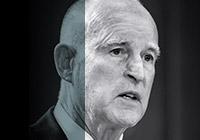J.R. DESHAZO GREW UP IN RURAL VIRGINIA, the oldest of seven children in a blue-collar household warmed by firewood. Now he devotes his research and intelligence to weaning Americans off fossil fuels — first by examining behavior and then by scrutinizing policy.
His mission starts with consumers, but aims really at policymakers. That’s because, though some of the challenges of climate change are technical, others are political. If society is going to recognize and adapt to a warming planet, it will require thoughtful policies to encourage those adaptations. That’s where DeShazo comes in.
In his role as director of the Luskin Center for Innovation, DeShazo, a UCLA professor of public policy and urban planning, leads research in renew- able energy — power that is generated from natural resources (such as solar, wind, geothermal or water) and is naturally replenished. For DeShazo, that is both an environmental and a social challenge: Ensuring that low-income households have access to energy-conscious options is a personal goal, an outgrowth of his upbringing.
“I am very empathetic to low- and moderate-income family households in this country and other countries who are struggling just to live on a day- to-day basis,” he said. “It makes me work extra hard on projects that are related to low-income Californians. They are affected more by most of these policies because more of their income goes toward energy and water, as a percentage. So that’s a real consequence.”
After high school in Virginia, DeShazo went on to study economics and history at the College of William and Mary, where he graduated with honors before winning a Rhodes scholarship. He received his master’s degree in economics at St. Antony’s College at Oxford and then completed a Ph.D. at Harvard.
The 49-year-old father of two drives a plug- in electric vehicle and has installed solar panels on his house. “Yes, my 16-year-old is driving an electric vehicle, and the 4-year-old got to watch the solar panels go on the rooftop — and he was very excited about that,” DeShazo said with a laugh. His wife, Mary Evans, is an environmental economist who teaches at Claremont McKenna College.
Studying habits and changing them
A key part of DeShazo’s work involves analyzing the behavior of consumers and utilities, then finding ways to help them meet their individual goals, whether it’s saving money, reducing greenhouse gas emissions, or both. He has been called upon to advise and assess the policies of the U.S. Environmental Protection Agency, the United Nations, the California Air Resources Board, the Los Angeles City Council and numerous other agencies.
“We help utilities and utility regulators think about how to design programs to incentivize or to bring more clean power into the air,” he said. “And we help consumers think about the choices they make by investing in energy efficiency.”
There’s a wealth of energy alternatives on the market today: Electric vehicles, solar rooftop panels and xeriscaping are just a few of the available clean technologies. The trick is to get consumers to consider and ultimately change their consumption habits and to get providers to come up with more options.
The most basic challenge is learning how to talk to consumers about energy. DeShazo has found that American households respond differently to messages on energy savings. For example, he said, “Conservatives really don’t like to be told what to do by government policymakers.” In those cases, it’s best to appeal to their desire to save money, and their desire for the country to be more energy independent. For lower-income households, he says, emphasizing cost savings is most effective.
When education is coupled with rebates or subsidies, all sides see re- wards. “The great thing about that strategy is that it produces a social benefit and an environmental benefit.” But, DeShazo says, lawmakers must ensure incentives go to the people who need them the most.
The classic complaint, he says, is that subsidies are going to rich people. “’Why do you want to give a Tesla owner a $5,000 rebate?’ Is it really going to make a difference if they’re buying an $80,000 car to give them a $5,000 reduction, compared to a household that might be considering the purchase of a $12,000 car?”
The same is true of solar rooftop panels, which can run at least $15,000 to $20,000 for a typical house. That purchase, even after rebates and credits, may not pay for itself for 10 years. So right now it’s easier for a higher-income household to make the investment and wait for the return, which could come in the form of direct energy savings, rebates on electric bills or the possibility of selling power back to the utilities, DeShazo says.
New markets for new cars
Much of DeShazo’s recent work at Luskin has focused on plug-in electric vehicles, an emerging market that has become a top-10 priority for many states.
In March 2015, for instance, DeShazo and several other researchers published a state-by-state analysis of attempts to encourage the development of plug-in vehicles, from creating tax rebates to enlarging the electric charging infrastructure to make the vehicles more usable. The report, “State of the States’ Plug-in Electric Vehicle Policies,” was co-authored by DeShazo, CC Song, Michael Sin and Thomas Gariffo. Its findings are helping to guide California and others in pursuit of a new vehicle mix for American highways.
As of December 2015, sales of plug-in vehicles in the United States topped 400,000, with 170,580 sold in California, according to the California Plug-in Electric Vehicle Collaborative. The pub- lic-private consortium is made up of 48 partners, ranging from global automakers and utilities to Gov. Jerry Brown’s office. Their common goal is to expand the plug-in vehicle market.
“California accounts for about 45% of national EV sales,” said Josh Boone, deputy executive director of the consortium. “We are not only the national leader for plug-in electric sales, we’re also the global leader.”
Worldwide, more than 1 million EVs have been sold, according to a recent survey by HybridCars. com, which tracks plug-in vehicle sales. Plug-in vehicles fall into two basic categories: battery-electric vehicles and plug-in hybrid electric vehicles. Because battery-electric vehicles have no internal combustion engine and are fully powered by an electric motor, they are considered zero-emission vehicles, while hybrid cars are zero emission only when in electric mode.
California has a long history of strong air-quality regulations and hefty consumer incentives for adopting energy alternatives. Energy policy has been motivated largely by the state’s commitment to dealing with pollution and climate change. To that end, Gov. Brown issued an executive order in 2012, setting a goal of 1.5 million zero-emission vehicles in California by 2025. Nationwide, President Barack Obama has made a push for 1 million plug-in electric vehicles on the road.
Progress, challenges
There’s still a long way to go.
In December, Mary Nichols, chair of the California Air Resources Board, told the Los Angeles Times, “We’re not currently on a path that will lead us to the 1.5 million.” David Clegern, a spokesman for the board, said the state has undertaken a number of measures to speed the growth of the zero-emission vehicle market, which include investing in more charging stations and steeply increasing annual vehicle delivery requirements for automakers, which would require that 15 percent of new cars for sale in California by 2025 be zero-emission vehicles. Some companies are developing electric cars precisely so that they can have access to markets in California and Oregon, which also has imposed mileage requirements.
As more people are encouraged to buy plug-in cars, automakers will likely boost production and offerings to feed the growing market. That’s why DeShazo’s consumer-focused research is key. “It’s going to be easier if you see a neighbor try it out,” DeShazo said. “You learn from them when you talk. It’s a kind of peer-to-peer education. That process takes time.”
Sales have increased, in part, through such enticements as rebates, access to preferred parking spots and carpool lanes and other initiatives. “We hear from our automaker members and from the driving community that incentives are one of the key factors in pushing folks to purchasing or leasing an EV,” Boone said.
However, financial incentives are not meant to be permanent; they are designed to help jump-start new technologies. The good news is that research shows that early adopters have additional motivations. “Most of them are doing it for environmental reasons or they want to try new technologies,” DeShazo said. “People like whatever is new.”
Though electric cars have been around in some form since the late 1800s, the first mass-market, mass-produced hybrid vehicles have become available only in recent years. Early mass-market electric vehicles were introduced in the 1990s, but the benchmark year came in 2010, when the fully electric Nissan Leaf and Chevrolet Volt were introduced, marking the “second launch” of plug-in electric vehicles. Today there are about 30 electric or hybrid options available to consumers.
But it’s still considered a nascent market. “They’re viewed as a little bit risky — we’re still learning how to use them. People ask, ‘Are they going to work for me in my household in my situation?’” DeShazo said. “So you tend to only want to get one if you have an extra vehicle you can fall back on.”
Typically with new technologies, the more affluent have been among the early adopters, and the electric vehicle is no different. Research has found, unsurprisingly, that lower-income households don’t tend to buy new cars; they tend to buy used cars. Only recently have rebates been made available
for buyers of used cars. “One of the things we’re looking at is how do you match these rebates with financing arrangements that the [government] might want to provide a guarantee on,” DeShazo said. “Even if there is a higher-than-average default rate, it might be a better way to use public funds.”
Technological advancements are creating more price points for consumers. Electric cars include range in price from the $26,000 Chevrolet Spark or the Smart EV but also the $85,000 Tesla Model S 85D. Rebates and incentives bring down the price.
“It’s an exciting time,” Boone, of the California Plug-In Electric Vehicle Consortium, said. “The next generation of electric vehicles includes more affordable, longer-range plug-in hybrids and longer-range all-battery electric vehicles.”
At the Consumer Electronics Show in January, Chevrolet unveiled its 2017 Bolt EV, an electric car with a 200-mile range on a single charge, significantly increasing the current average range of 40 to 80 miles. The car is expected to cost about $30,000 after a $7,500 federal tax credit, making it more affordable for lower- and middle-income households.
As availability expands, so does the prospect of a modern transportation network decoupled from oil and gas. If it happens, it’s likely to begin in California – and it will be a credit to DeShazo and his colleagues.
“It’s exciting to do research on energy policy and climate change in California because we are a state that is willing to experiment, to adopt interesting policies,” DeShazo said. “Some of the ideas are out there and crazy, and some of them are really innovative and on the forefront of what the rest of the world is going to be doing. And we get to look at those and evaluate all of that. That’s exciting.”





















